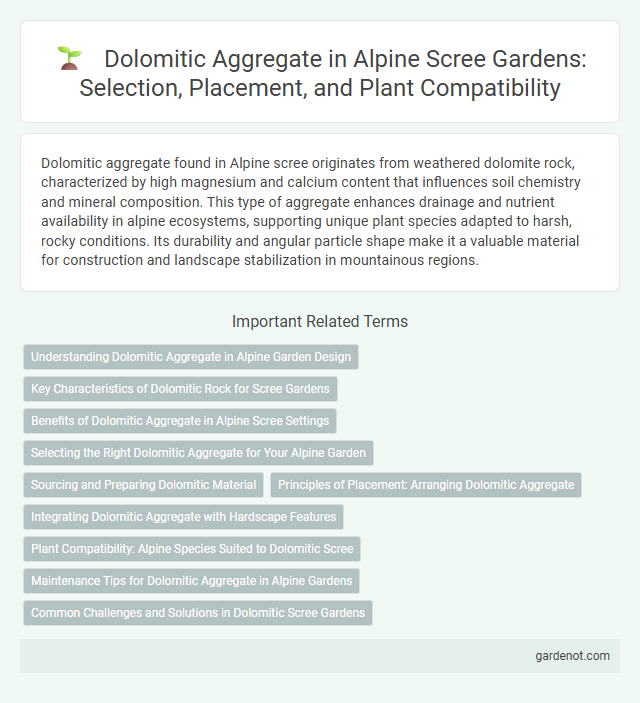Dolomitic aggregate found in Alpine scree originates from weathered dolomite rock, characterized by high magnesium and calcium content that influences soil chemistry and mineral composition. This type of aggregate enhances drainage and nutrient availability in alpine ecosystems, supporting unique plant species adapted to harsh, rocky conditions. Its durability and angular particle shape make it a valuable material for construction and landscape stabilization in mountainous regions.
Understanding Dolomitic Aggregate in Alpine Garden Design
Dolomitic aggregate, composed primarily of calcium magnesium carbonate, offers excellent drainage and mineral-rich properties essential for alpine garden substrates. Its natural resistance to weathering and ability to maintain soil stability supports the delicate root systems of alpine plants in scree environments. Utilizing dolomitic aggregate in alpine garden design enhances authenticity, mimicking the nutrient profile and texture of native Dolomitic scree habitats.
Key Characteristics of Dolomitic Rock for Scree Gardens
Dolomitic aggregate used in alpine scree gardens features high magnesium and calcium carbonate content, providing excellent durability and weather resistance. Its naturally angular texture promotes effective drainage, preventing water accumulation and root rot in scree environments. The light gray to pinkish hues of dolomitic rock enhance aesthetic appeal while supporting native alpine vegetation adapted to rocky, alkaline soils.
Benefits of Dolomitic Aggregate in Alpine Scree Settings
Dolomitic aggregate enhances Alpine scree stability by providing high abrasion resistance and superior drainage, reducing erosion risks in steep mountainous terrains. Its chemical composition improves frost resistance, ensuring long-term durability under freeze-thaw cycles common in alpine environments. The mineral-rich nature of dolomitic aggregate also supports sustainable construction by minimizing environmental impact during sourcing and application.
Selecting the Right Dolomitic Aggregate for Your Alpine Garden
Selecting the right Dolomitic aggregate for your Alpine garden involves considering particle size, color, and mineral composition to mimic natural scree conditions. Coarser aggregates improve drainage and prevent root rot, while finer particles help retain moisture and support delicate alpine plants. Choosing aggregates rich in magnesium and calcium ensures optimal soil pH and nutrient balance for robust plant growth.
Sourcing and Preparing Dolomitic Material
Dolomitic aggregate used in Alpine scree is primarily sourced from quarries within the Dolomite mountain range, where high-purity dolomite rock is abundant. Extraction involves careful blasting and crushing to produce angular fragments that promote stability and permeability in scree formations. Processing includes washing and grading to remove impurities and achieve optimal particle size distribution for erosion control and natural slope reinforcement.
Principles of Placement: Arranging Dolomitic Aggregate
Arranging dolomitic aggregate within Alpine scree environments requires careful consideration of particle size distribution and layering to enhance stability and drainage. Optimal placement involves interlocking angular fragments to reduce displacement under stress, minimizing void spaces to prevent erosion while allowing sufficient water percolation. Ensuring a well-graded composition with appropriate compaction techniques strengthens the scree structure and mitigates slope failure risks in alpine terrains.
Integrating Dolomitic Aggregate with Hardscape Features
Dolomitic aggregate offers exceptional durability and natural aesthetics, making it an ideal material for integrating with hardscape features in alpine scree environments. Its high calcium magnesium carbonate content ensures resistance to weathering and freeze-thaw cycles, enhancing the longevity of retaining walls, pathways, and terraces. Using dolomitic aggregate not only strengthens structural stability but also complements the rugged alpine landscape with a cohesive, natural appearance.
Plant Compatibility: Alpine Species Suited to Dolomitic Scree
Dolomitic scree provides a unique substrate rich in magnesium carbonate, supporting alpine species such as Saxifraga oppositifolia, Androsace alpina, and Minuartia larvae-montani that exhibit high tolerance to alkaline, well-drained conditions. These plants demonstrate specialized adaptations for root anchorage and nutrient uptake in the coarse, unstable dolomitic aggregate environment. The compatibility of these alpine species with dolomitic scree makes them essential for ecological restoration and biodiversity conservation in mountain habitats.
Maintenance Tips for Dolomitic Aggregate in Alpine Gardens
Regularly removing debris and preventing weed growth are essential maintenance tips for Dolomitic aggregate in Alpine gardens to preserve its natural appearance and drainage properties. Periodic raking helps prevent compaction, ensuring optimal aeration and water infiltration around alpine plants. Applying a light top-up of Dolomitic limestone aggregate every few years maintains the substrate's pH balance and aesthetic consistency.
Common Challenges and Solutions in Dolomitic Scree Gardens
Dolomitic scree gardens often face challenges such as poor soil drainage, nutrient deficiency, and instability due to the angular nature of dolomitic aggregate. Solutions include incorporating well-draining substrates, applying slow-release fertilizers rich in magnesium and calcium, and using stabilizing mesh or retaining structures to maintain slope integrity. Selecting native alpine plants adapted to calcareous, rocky environments enhances resilience and supports ecosystem balance in dolomitic scree landscapes.
Dolomitic aggregate Infographic

 gardenot.com
gardenot.com